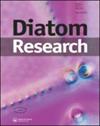Stephanodiscus coruscus sp. nov., a new species of diatom (Bacillariophyta) from June Lake, California (USA) with close affiliation to Stephanodiscus klamathensis
IF 1.3
3区 生物学
Q2 MARINE & FRESHWATER BIOLOGY
引用次数: 4
Abstract
Modern and fossil populations of a Stephanodiscus Ehrenberg species from June Lake, California (USA) were analysed using light and scanning electron microscopy (SEM). Stephanodiscus valves were a major constituent of almost all analysed samples, often dominating fossil assemblages dating back several thousand years. The most commonly observed Stephanodiscus specimen in the samples bore a striking resemblance to the extinct Late Pliocene species Stephanodiscus klamathensis, particularly under light microscopy. The population size range, ultrastructure, and other defining characteristics closely matched published information on S. klamathensis. However, under SEM, internal views of the specimens from June Lake showed an important difference; specimens lacked valve face fultoportulae, whereas S. klamathensis is characterized by the presence of two valve face fultoportulae, each with three satellite pores near the centre of the valve. Additional differences in valve size range, absence of fultoportulae on the valve face, and the fact that S. klamathensis is an extinct species (observed in diatomites deposited from Late Pliocene to Pleistocene) with no closely related living relatives, necessitates describing this Stephanodiscus as a new species. To date, Stephanodiscus coruscus has been observed only in June Lake, California; most Stephanodiscus that share strong morphological similarities to this species have only been observed in ancient fossil diatomites. Thus, Stephanodiscus coruscus Jeff. R. Stone, Edlund & Streib sp. nov. is not only a new species but also provides a rare glimpse into the likely types of environments that S. klamathensis and other similar ancient Stephanodiscus may have inhabited in the late Pliocene. Character variations between S. coruscus and S. klamathensis reveal potential patterns of evolution in freshwater lineages, such as character loss, over time.珊瑚Stephanodiscus coruscus sp.nov.,产于美国加利福尼亚州六月湖的一种硅藻(Bacillarophyta),与克拉马氏Stephanodiescus klamatensis亲缘关系密切
使用光学和扫描电子显微镜(SEM)分析了来自美国加利福尼亚州六月湖的Stephanodiscus Ehrenberg物种的现代和化石种群。Stephanodiscus阀是几乎所有分析样本的主要组成部分,通常在几千年前的化石组合中占主导地位。样本中最常见的Stephanodiscus标本与已灭绝的上新世晚期物种Klamathiensis有着惊人的相似之处,尤其是在光学显微镜下。种群大小范围、超微结构和其他定义特征与已发表的关于克拉马氏S.klamathiensis的信息非常吻合。然而,在扫描电镜下,六月湖标本的内部视图显示出重要的差异;标本缺乏瓣面富尔通孔,而克拉马氏S.klamathiensis的特征是存在两个瓣面富尔通孔,每一个在瓣中心附近都有三个卫星孔。阀瓣大小范围的额外差异,阀瓣面上没有富尔托波图拉埃,以及克拉马先斯是一个已灭绝的物种(在上新世晚期至更新世沉积的硅藻中观察到),没有近亲,因此有必要将这种Stephanodiscus描述为一个新物种。到目前为止,只有在加利福尼亚州的六月湖才能观察到斑蝶;大多数Stephanodiscus与该物种有着强烈的形态相似性,只有在古代硅藻化石中才能观察到。因此,Stephanodiscus coruscus Jeff。R.Stone,Edlund&Streib sp.nov.不仅是一个新物种,而且还罕见地了解了克拉马先斯和其他类似的古Stephanodiscus可能在上新世晚期居住的环境类型。C.coruscus和S.klamathiensis之间的特征变化揭示了淡水谱系的潜在进化模式,例如随着时间的推移,特征的丧失。
本文章由计算机程序翻译,如有差异,请以英文原文为准。
求助全文
约1分钟内获得全文
求助全文
来源期刊

Diatom Research
生物-海洋与淡水生物学
CiteScore
2.70
自引率
16.70%
发文量
27
审稿时长
>12 weeks
期刊介绍:
Diatom Research is the journal of the International Society for Diatom Research. The journal is published quarterly, in March, June, September and December, and welcomes manuscripts on any aspect of diatom biology.
In addition to full-length papers, short notes and reviews of recent literature are published which need not contain all the sections required for full-length papers; we see these as being necessary to record information which is of interest but which cannot be followed up in detail. Discursive “Opinion” papers are encouraged which would not necessarily follow the normal lay-out. If extremely long papers are to be offered, the author(s) should contact the editors first to discuss any problems. Book reviews, obituaries and meeting reports can be published. All papers will be subject to critical review by the editors and referees, as appropriate to their content. Papers will be accepted in English only.
 求助内容:
求助内容: 应助结果提醒方式:
应助结果提醒方式:


